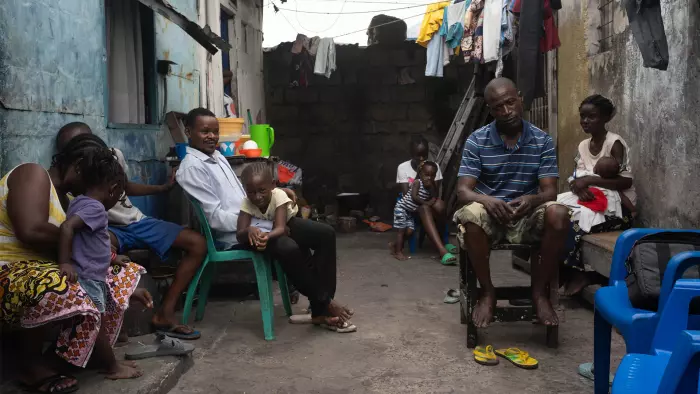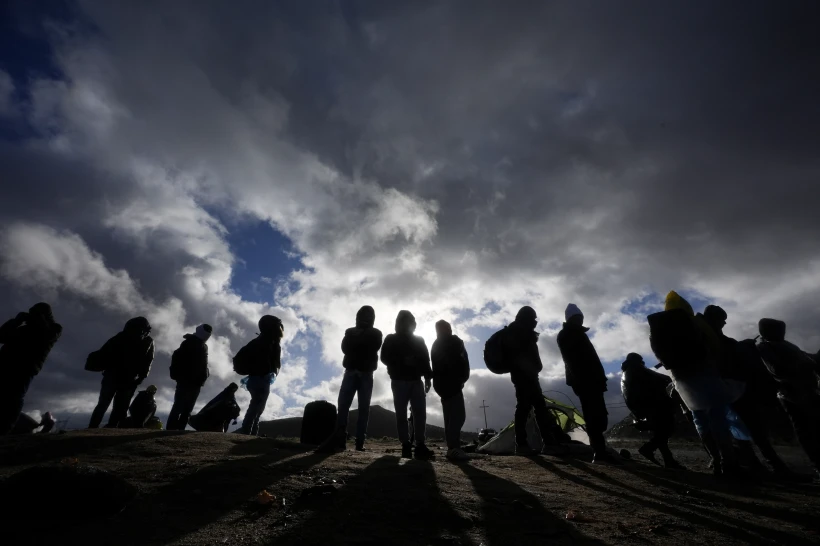
A courtyard in a hardscrabble neighbourhood of Kinshasa, the capital of the Democratic Republic of the Congo, is strewn with plastic chairs and clothes lines. Mats are lined up on the concrete floor for children to sleep on. A power cut means it’s almost pitch-black.
The roughly 140 residents of the courtyard are Teke people who fled Kwamouth in the province of Mai-Ndombe, some 200 kilometres north of Kinshasa, after a militia known as the Mobondo attacked their village in September 2022.
John Mushebi, 58, a Kinshasa resident whose parents hailed from their village of Ingwene, welcomed as many survivors as he could into his property in the capital.
“They’ve received no assistance. They’re abandoned to their fate,” Mushebi explained recently, deploring a lack of government help. Three displaced children living in the courtyard had recently died, at least one of them from cholera.
The knot of survivors sheltering in Mushebi’s compound are among at least 160,000 people – some estimates say far more – who have fled their homes due to the conflict in Kwamouth, which was sparked in mid-2022 by a dispute over traditional tithes owed to Teke chiefs in the region.
The dispute quickly spiralled. The newly formed Mobondo militia – comprising Yaka people, as well communities judged to be related to them – sprang up and began to drive the Teke and their perceived allies from their villages. The violence spread into neighbouring western provinces, even reaching the capital province of Kinshasa.
Compared to the conflicts that plague eastern DRC, where tensions are increasing between Congo and neighbouring Rwanda over the advance of the M23 rebel group, little international attention has been paid to the unrest in Kwamouth, despite its proximity to the capital.
The focus has instead been on the eastern city of Goma, blockaded by the Rwandan-backed M23, amid fears in recent weeks that it could fall. The Congolese military launched pacification operations last year against the Mobondo militia, but the government banned journalists from travelling to three of the provinces affected by the violence.
“The situation is under the control of loyalist forces, who are carrying out in-depth clean-up operations,” Congolese army spokesman Sylvain Ekenge said.
What little information has leaked out paints a picture of extreme violence, with villages torched and looted across the territory. Bardo Kamona, another survivor of Ingwene, said Mobondo men – “masked and covered in soot” – attacked the village at 3am, searching houses and killing scores of people, including the traditional chief.
“There’s no way to go home,” the 39-year-old woman said, speaking from a property not far from Mushebi’s courtyard where she had taken refuge with 20 others after a week-long journey to Kinshasa on foot.
The violence is ongoing. About 10 people were killed in an attack on a village in Kwamouth on January 23 and another seven were reportedly killed in the next-door province of Kwango on February 2.
It’s unclear how many people have died in the conflict so far, although a December report by a UN group of experts pointed to hundreds of civilians killed on both sides. The real death toll is considered to be much higher.
The humanitarian impact of the crisis has been dire. Florian Monnerie, country director for relief agency Action Against Hunger, said between 500,000 and 600,000 people had been affected by displacement – either displaced themselves or hosting people who had fled the violence.
“We can’t really know the real numbers,” he explained. “They are all in need of immediate humanitarian aid.”
Kwamouth is considered poor even by the standards of the DRC, a country still struggling with its colonial legacy, failures of successive governments and decades of conflict. Most of its inhabitants engage in subsistence farming to survive, but their farms are now unsafe to tend.
“These dissident groups develop their war economy, at the expense of the population.”
Only two main roads cross the territory, which are sometimes subject to militia roadblocks or attacks, complicating humanitarian access. Most aid efforts are therefore focused on settlements near the Congo river.
The interior of Kwamouth, which includes lush forested areas, is mostly under Mobondo control, and is particularly difficult to access. Militia have attacked about half of the villages in the territory, according to an October report by the NGOs Magna and Caritas, and the Archdiocese of Kinshasa.
“These dissident groups develop their war economy, at the expense of the population,” the report said.
In September, the same organisations reported that militiamen controlled 73 of the 144 villages in Kwamouth.
Teke people own much of the land in Kwamouth. Communities from neighbouring provinces – who are considered “non-native” – have historically provided agricultural labour. Some have also settled on the land as farmers, and are taxed in-kind by Teke customary chiefs.
In 2022, Teke chiefs announced a tax increase, stoking existing tensions. When Teke leaders tried to enforce collections, a Yaka farmer was injured in a confrontation in June of that year, which triggered the killing of a Teke chief and the burning down of a village.
“Emboldened by the lack of resistance of the [Teke] villagers, who preferred abandoning their village rather than facing more violence, the Yaka farmers began inciting others to refuse the payment of taxes,” said the UN group of experts’ report.
A mysterious figure, who claims to be the traditional king and spiritual leader of the Yaka, known as the “Kiamvu”, then appeared on the scene and founded the Mobondo militia, according to several reports and testimonies from displaced people.
The militia relies heavily on the use of traditional rituals. Fighters – who are not only Yaka – go into battle painted and wearing talismans, according to witness testimonies, and wield machetes, hunting rifles and other small arms.
Survivors of their attacks say the Mobondo aim to conquer much of the Congolese section of the Bateke Plateau – a stretch of land that covers parts of Gabon, the Republic of Congo, as well as Kwamouth and the northern part of Kinshasa province. They contend that it is part of the ancient Yaka kingdom of Lunda.
Analysts view the militia’s tactics as sophisticated. They have staged coordinated ambushes on military targets, and advanced close to Kinshasa before being repelled by the army. The UN experts’ report described the Mobondo as executing “military-like attacks” and gaining access to “AK-type assault rifles, PKM machine guns and grenade launchers”.
One human rights researcher monitoring the conflict, who declined to be named for security reasons, suggested that some Mobondo were ex-soldiers. “It’s a form of guerrilla warfare. These aren’t simple villagers,” he said.
The army’s response to the militia when it entered Kinshasa province was “ferocious”, the researcher said, adding that although the Mobondo have been pushed back into rural Kwamouth, they still make sorties elsewhere.
“The assailants consider the territory as already conquered,” the researcher said. The Teke, for their part, refuse negotiations and expect the government to eliminate the militia. “It’s difficult to envisage a solution in the months to come,” he added.
The New Humanitarian was unable to reach representatives of the Yaka people. According to several officials and rights workers, many from the community feel unfairly targeted due perceived associations with the Mobondo, and are reluctant to speak.
Bob Mbobilo, a Kinshasa-based lawyer who advocates on behalf of displaced Teke, admitted that the conflict started over taxes but argued that the dispute did not justify waging war. Teke and Yaka lived side by side for years, he pointed out.
“The displaced live in an inhumane situation. They sleep outside, without mosquito nets,” Mbobilo said. “The government doesn’t help them.”
- The New Humanitarian report











